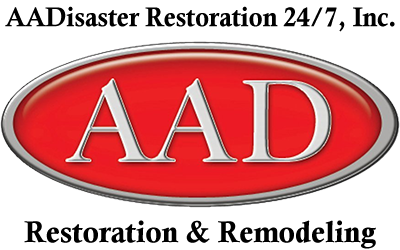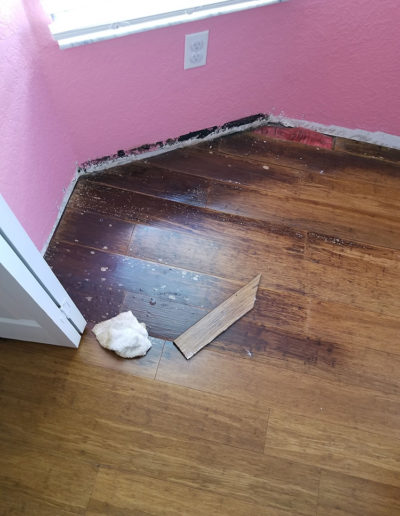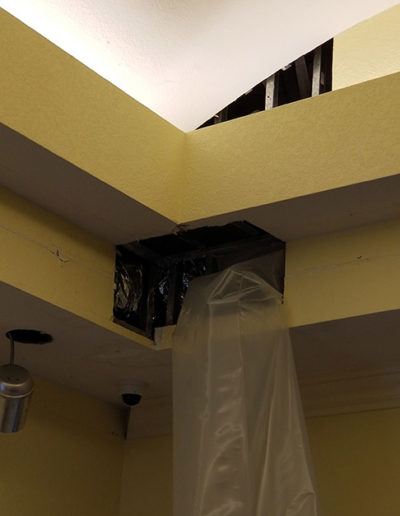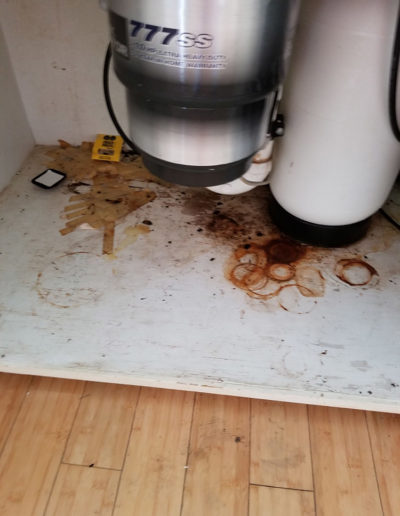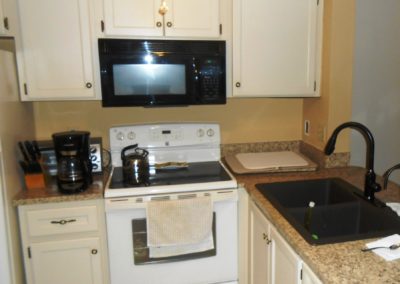Water Damage
Surprisingly, some of the most severe water damage can be caused by a small leak in a roof, a pipe or an overflow of a toilet. Even if you react quickly and think you cleaned up the visible water completely there is no way to see where the water may have gone. It is possible that the water may have penetrated structural cavities and been trapped.
Water extraction, clean up and drying must be done immediately to avoid and mitigate any significant water damage to your property. Ineffective clean up and drying can cause serious property damage and health issues. Since most property owners are not familiar with the steps to properly dry a water loss, it is important to call the professionals. AADisaster Restoration24/7, Inc. has been formally trained and certified to perform water extraction and clean up. (Lic. #MRSR31) We understand what needs to be done to efficiently remove water, promote evaporation and dehumidification conditions to possibly restore floors, carpets and walls to mitigate damage and rebuild. (Lic. #CBC1259116) We currently service the entire S.W. Florida area including, Charlotte County, Lee County, Sarasota County, Collier County and DeSoto County.
Common Causes
The Most Common Causes of Flood or Water Related Damages
- Pipe Leaks: Failure to fix a simple leaky pipe can cause serious water damage, mold or a flood because your pipe burst. Look around your house, check your walls and ceilings for water damage and look for any persistent mold that is growing on your walls or roof.
-
Water Heater Leaks or Burst: This is a tricky appliance to inspect, so it is best to keep it outside of your house, in your garage. There are also shallow water heater pans that the appliance can sit in. In case of a leak this will help mitigate any water damage in your home.
-
Washing Machine and Dishwasher Leaks: Check appliance hoses regularly and replace any hose that is old or worn. Make sure that all the hoses are properly tightened and installed to avoid leaking.
-
Sprinklers and Flower Beds: Keep sprinklers away from the house. NEVER have water hitting directly on your home. Keep moist dirt, trees, bushes and plants away from your home’s outside walls. Continuous moisture will eventually cause mold and water damage.
-
Leaking Roof: Slow persistent leaks cause some of the most serious problems. Inspect your roof each year during the Spring and Fall and especially after a severe storm, such as a hurricane. Fix all problems quickly to avoid any serious leaks and to help with the longevity of your roof.
-
Over Flowing Sinks and Bathtubs: Never leave running faucets unattended. An overflow of water can cause serious damage to flooring and drywall.
-
Over Flowing Toilet, Sewer or Drain Problem: One of the worst kinds of water damage involves sewage leaks and over flows. The bacteria and contamination, especially in your home, make this a health emergency. Professional clean up is necessary. When something like this happens to you, CALL AADisaster Restoration 24/7, Inc. anytime at 866-509-4561.
Things to Know
Roof Maintenance Tips
-
Keep your gutters and downspouts clear of any debris.
-
Keep trees pruned and branches from hanging over the roof.
-
Lighter color roofs tend to last longer than darker roofs.
-
Keep your roof from overheating.
-
Every roof needs to breathe, make sure there is proper ventilation and the vents installed do not leak and are installed properly.
-
Sun exposure will change the longevity of the roof.
Basic Inspection
-
Look for cracked, torn, balding or missing shingles.
-
Check the drip edges and flashing, make sure they are not torn or curling.
-
Crawl into your attic and look for water stains near corners and around trusses.
-
If you see any problems with your roof, contact at least 3 licensed and insured roofing companies and get estimates regarding your roof repairs.
-
Baseboards separating from the wall can indicate a moisture intrusion issue.
-
Tile popping up slightly can be the result of water damage.
-
Kitchen cabinets under the sink swelling can be a sign of water damage.
FAQ’s
For a small water loss in my house, is it ok to dry it up myself?
One thing you need to keep in mind when dealing with a water loss is that only a portion of the water loss is visible. You may think drying it up yourself will save money, but if not done properly, a water loss can result in a costly mold problem. When dealing with a water loss, it is said that only 20% of the water is visible, while the other 80% can be in the drywall and surrounding building materials.
Water damage in your home: what to look for.
Discoloration of walls is a major indicator of internal water loss. Often these water losses can be the perfect breeding ground for mold as they often go undetected for some time. If you suspect a water loss, call AADisaster Restoration24/7 for a free inspection. Trying to remove the drywall yourself can create a bigger problem because doing so may disperse mold spores if they are present.
